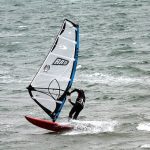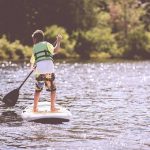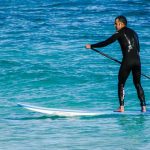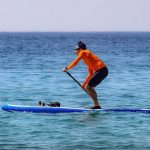Quite a bit of equipment is needed to get into windsurfing. The things that are necessary in order to go windsurfing are the board, sail, mast and mast base, rig, boom, and uphaul rope. If you want to go surfing, you will need to buy some protective gear first.
This includes items such as a helmet, wetsuit, water shoes, lifejacket, and buoyancy aids. A complete set of brand-new windsurfing gear that you can purchase online can cost you more than 3,000 dollars.
Windsurfing is a sport that is a combination of surfing, wakeboarding, and sailing, among other water activities. It is highly physical and requires a lot of stamina. The sport of BASE jumping has been increasing in popularity among thrill-seekers all over the world over the past year.
Here’s what you need to know to get started in the sport, including how much it costs.
What Do I Need to Windsurf?
Windsurfing requires more equipment than other water activities and board sports. Much of the equipment needed for windsurfing is for the actual sport, while other pieces are for your safety.
Here is a list of the essential gear that you would need for windsurfing:
- The windsurfing board
- The sail
- The mast and mast base
- The uphaul rope
- The universal joint
- The rig
- The boom
- Helmet
- Wetsuit
- Buoyancy Aids
- Aqua shoes or water booties
- Rescue coat or lifejacket
- Sunglasses
How Expensive Is Windsurfing?
Although it can be costly to windsurf, whether you want to try it for a few hours or get serious about the sport, it can be enjoyable. If you wanted to take beginner skiing lessons for just two days, it would cost you a few hundred dollars total.
I’m assuming you want to pursue the sport of downhill mountain biking? If so, it will be more expensive the more serious you are about it. If you want to learn the basics of a language thoroughly, you would need to enroll in a longer beginner course.
Safety is the number one priority when windsurfing. Quality gear is a must in order to avoid any accidents.
What Do You Wear for Windsurfing?
You have many choices for what to wear while windsurfing. Make sure to wear your boots in the appropriate locations and weather conditions.
- Wetsuit: This is the most common attire used in windsurfing. Wetsuits are designed to keep you warm while also protecting you against injuries. Ease of movement is also one of the most important design concepts that go into the making of wetsuits.You should always take into account your windsurfing location of choice because wetsuits are made with varying thicknesses. For beginners, a wetsuit that is 2.5 to 3 millimeters is okay. If you happen to be windsurfing in the tropics, you can pick a thinner wetsuit.
Conversely, you should get thicker wetsuits if you like windsurfing during the cold months.
- Rashguard: This is another popular option for windsurfing. A well-made rash guard will protect you from both the coldness of the water and the heat from the sun. You can pair this with the next one.
- Board shorts: This is usually the bottom of choice for windsurfers. Some board shorts are even waterproof, so you won’t be cold even if you get splashed by the waves.
If you want to try windsurfing in board shorts, pick those that are secured with a string and try not to buy those with Velcro straps. Stringed ones are more secure, especially if you get wiped out by the waves.
- Bathing suits: If you happen to be in the tropics and the waves are not too big, you can opt to don a bathing suit. They offer ease of movement, and they are a great choice if you don’t mind getting wet or getting a little sunburned.
If you want, you can always wear a t-shirt or a rash guard on top of your swimming tops.
- Water shoes, aqua shoes, and water booties: While you are allowed to ride your windsurfer barefoot, it is still recommended to wear water shoes, especially if you are windsurfing during the cold months.
Shoes will protect your feet from the cold and from any possibility of injury, bruises, or scratches that you might suffer from the ocean.
One of the benefits of windsurfing is that you don’t have to wear a lot of clothes. Although you can wear whatever you want when participating in the sport, it is always best to wear sunscreen to protect yourself from the sun.
How Do I Choose Windsurfing Equipment?
Do you want beginner equipment or something more advanced? What are the different decisions you should make before choosing your windsurfing gear?
Your beginner set should include the following:
- A board with a soft deck, a volume of 180 to 200 liters, and a retractable daggerboard
- A square sail that is at least 5 meters long
- An aluminum boom that can be extended from 150 to 160 centimeters to 200 to 210 centimeters
- Harness lines that can either be adjustable or fixed
- A standard diameter mast (SDM) extension that is at least 30 to 45 centimeters
- An uphaul line that will help you recover your sail from the water
- A wetsuit (preferably made of neoprene) that can protect you in both cold and warm climate
- Harness
- Life jacket
When considering buying secondhand gear, it is best to make sure that it is still in good condition. If you are serious about the sport, you should invest in quality gear.
If you are still unsure about what equipment to buy, you can always visit a shop that specializes in windsurfing gear and get recommendations from the staff. Windsurfing is a very physically demanding sport. If you buy low-quality equipment, you can still be injured even if you are well trained.
What Size Windsurfing Board Should I Get?
The size of the windsurfing board you want to purchase should be based on your individual size and skill level, as well as the water conditions and type of windsurfing you plan to do. Bigger people generally want bigger skateboards, and smaller people usually want smaller skateboards.
However, a larger board is better in light wind, and as your skills improve, you will want a smaller board for most kinds of windsurfing.
For people who are first learning, you will want a board with a daggerboard that has at least 180 liters of volume. The volume of the board can give you an idea of how stable it will be. More liters of volume on a board will make it easier to balance.
The width of the board is also a factor.
A board that is 200 liters in volume would be more stable if it was 90cm wide, rather than 70cm wide. It is best to talk to us about your specific situation so we can give you more accurate advice.
How Do I Properly Maintain My Windsurfing Board?
To keep your board in good condition, you don’t need to do much. You should store it in a place where there is no direct sunlight because the finish might start to break down if there is too much UV exposure.
A bag will be helpful to protect your board if you plan on keeping it on the top of your car or stored outside. It is advisable to fix any cracks or dings in your board before taking it out in the water again. It is best to keep the inside of the board dry, but it isn’t fatal if it gets wet.
You should occasionally rinse your board with fresh water if it has an adjustable mast track, to keep it from getting jammed up with sand and/or salt.
How Do I Know When I Need a New Windsurfing Board?
The reasons you may need a new board are if the current one is too damaged to fix, it is an old model, or it is not the right type of board for the windsurfing you want to do. Your board will last longer and function better if you replace it after 10 years or if it needs major repairs.
If you’ve got an older board, you’ll notice a big difference in how well a new one rides. They’re also easier to learn and progress on.
If you are having difficulty windsurfing on a large beginner board in high winds, it may be time to switch to a smaller board. If you want to focus on improving your skills in a particular area of windsurfing, such as freestyle, foiling, or wave sailing, you will want to get a board that is designed specifically for that purpose.
Important Things to Do/Know Before Buying a Windsurfing Board
If you can, get a lesson in before buying your first windsurfing board. This is an opportunity to learn the basics of windsurfing on a larger board with a smaller sail than what you would ultimately want to purchase. It is important to select a board that matches your size, ability level, and the conditions in which you will be using it.
Do not purchase a windsurfing board that you will “outgrow.” This generally leads to dissatisfaction and makes the process of learning to windsurf more complicated.
Trying out different boards before making a purchase can be beneficial, but it is essential to keep in mind that it is tough to compare boards if you’re testing them in different conditions, or in conditions that won’t be the same as the ones you’ll be using the board in at home.
Make sure to ask questions and get advice from your windsurfing shop before making any decisions. At our store, we want to ensure that you get the best board for your needs. We have a lot of experience helping people choose the right board, and we would be happy to help you too.
We can help you find the perfect board whether you schedule a lesson, rent a board, or just come down to our shop.
Types of Windsurfing Boards
Longboard
A longboard is a type of surfboard that is longer and has more buoyancy, making it easier to stand on while not moving. It also has a centerboard, which helps it perform better in light wind. Boards that are good for beginners as well as some high-performance race boards designed for light windy conditions fall into this category.
You will be better off using a longboard that is fairly wide if you are just starting out. On the other hand, if you are more advanced and Try to improve your skills in light wind conditions, you should use a narrower longboard.
Shortboard
Shortboards are used in higher wind. Unlike longboards, these boards are not very buoyant and require you to be constantly moving to stay on them. The only difference between a short and long board is that a short board doesn’t have a daggerboard.
These include the Fish, the Funboard, the Hybrid, the Mini-Mal, and the Retro. There are several types of short boards, including the fish, the funboard, the hybrid, the mini-mal, and the retro.
Waveboard
Wave boards are often quite small boards that are used while surfing to jump waves. The board is designed to provide good performance when turning, carving on a wave, and jumping. If you are looking for a board that will be good for all-around windsurfing in rough water, you should look for a “bump and jump” style of board, not a wakeboard.
This is because wakeboards are not designed for speed.
Bump and Jump Board
A high-wind shortboard that is designed to work well in rough water, is good at jumping (and landing), is faster than a wave board, but still has a performance emphasis on control and turning. This type of shortboard is the best choice for windy days and waves.
Slalom Board
A board made to go fast! A slalom board is designed to be fast in a straight line, but turning it around requires a lot of skill and technique. A slalom board that is true will work better with sails that are for racing.
If you are looking for a board that will make you the fastest guy on the water but you are not a professional windsurfer and still want to use your freeride sails, then the Fanatic Jag is the board for you.




